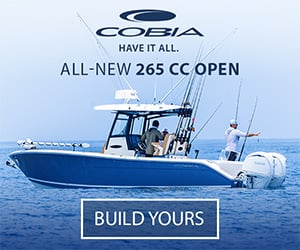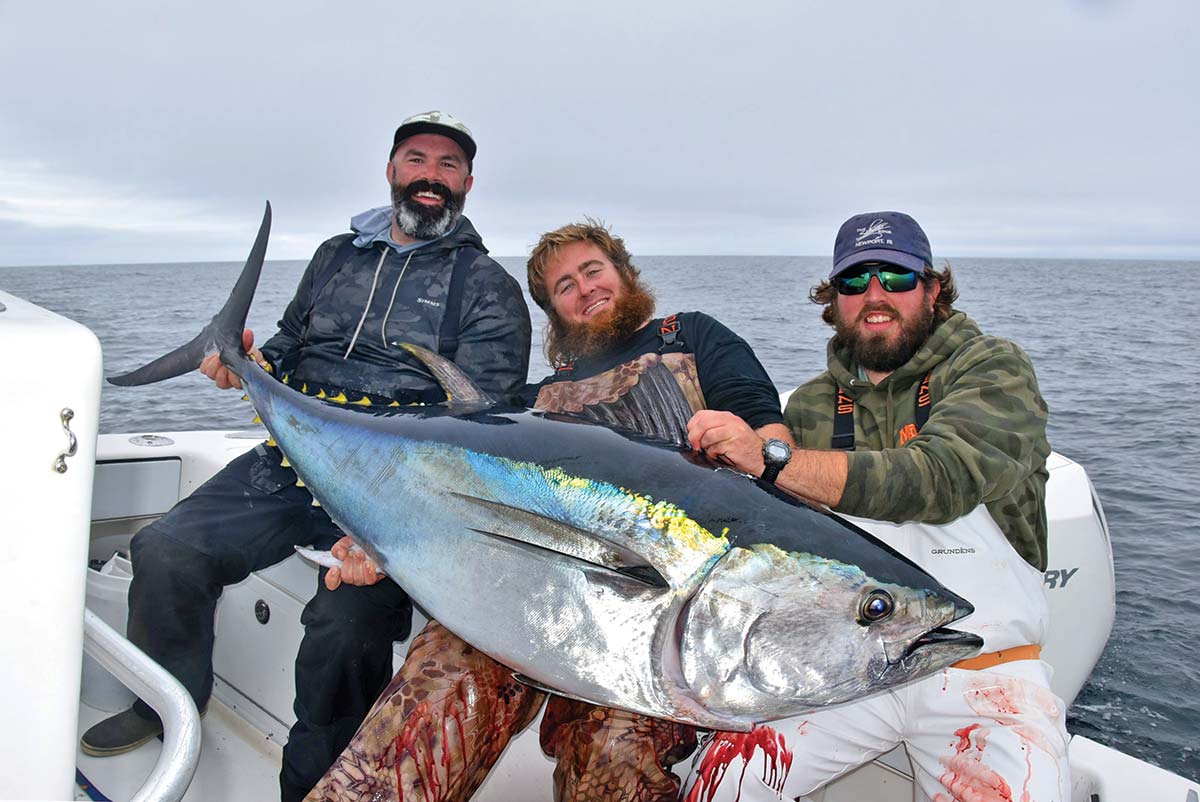
The actions of marine mammals can tell you a lot about the likelihood of hooking up with pelagic species.
The many recent innovations of boat electronics, satellite imagery and the free exchange of Internet information have certainly provided offshore anglers with new tools to help them get on the bite. But lost in this technological race are some of the observational skills that have guided captains and crew to productive fishing since time immemorial.
Much like how today’s hunters lament the loss of “woodsman skills” in the modern age, offshore crews seem to be too glued to their instrument screens and mobile devices, rather than honing the abilities of the best – and oldest – tools we have for finding fish on the open ocean. I’m talking about our own senses: sight, sound and smell and of course, our big ‘ol brains. Learning to read the signs offshore, and applying a bit of knowledge to those observations, still remains the best tools we have for fishing success, particularly when it comes to understanding the behavior of some of our very best allies out there: whales.
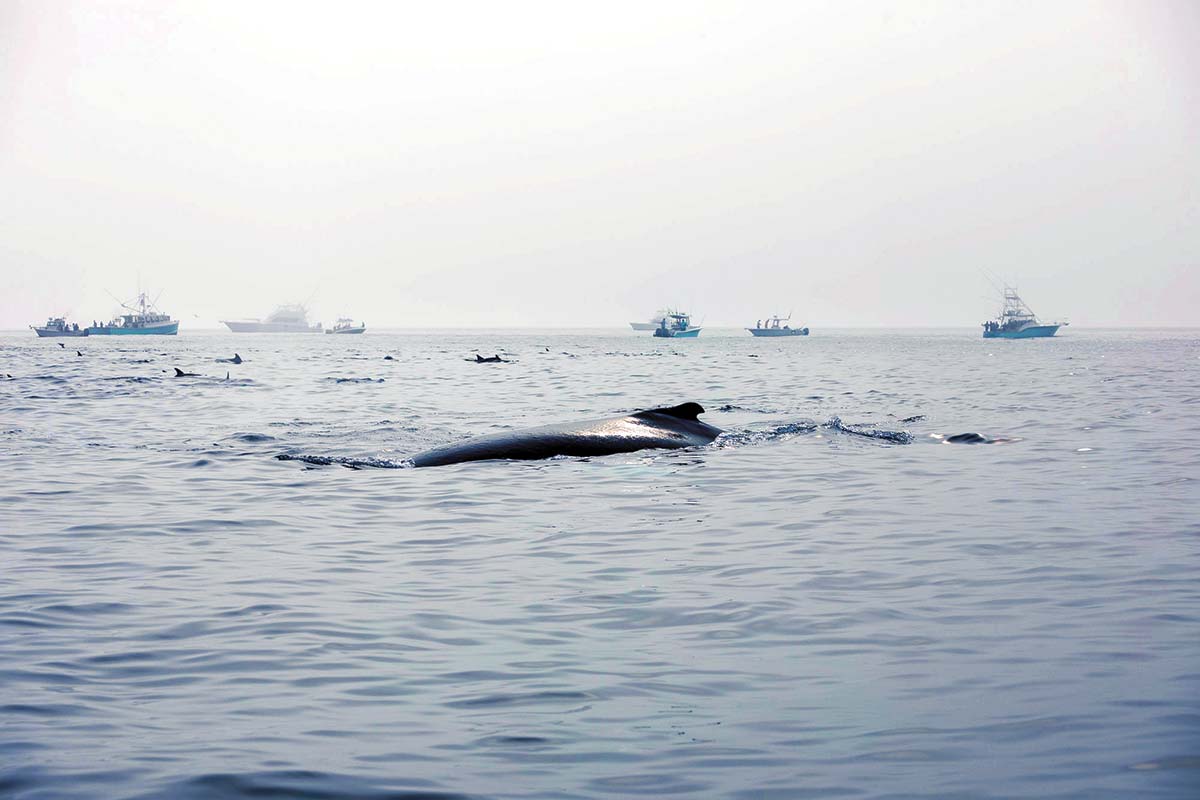
Thar She Blows!
Any time you can find a congregation of whales offshore, you’ve already eliminated a lot of empty ocean. The magnificent creatures roam huge distances, and dive to amazing depths, and these efforts require a lot of fuel. An adult humpback can weigh 50 tons, and that kind of bulk requires feeding for much of the daylight hours. So, even in locating a group of whales, you’ve probably already found a big biomass of bait – be it sand eels, menhaden, herring or mackerel; and logic follows that you’re in a good spot to connect with tuna or other pelagic species.
Usually there will be masses of birds like petrels, shearwaters or terns wheeling and feeding around active whales, and although modern marine radar promises the ability to locate such “bird balls” I believe the best tool for the job remains a quality set of binoculars. Some of these offshore birds have a better sense of smell than a bloodhound, so they are able to pick up a whale feed (or even a whale fart) from far away and hone in on the action. Remember, the bait brings the whales, the whales bring the birds, and one hopes that tuna are equally in the mix and in an equal feeding mood.
One of the best feelings in the offshore hunt is looking out to the horizon and seeing so many whale spouts that it looks like a forest of white trees on the ocean. When I see that, my heart skips a beat and my throttle lever goes into the corner. However, finding the whales is often the first step to success – another factor many anglers don’t consider is what sort of behavior the whales are currently exhibiting. I’ll detail some of the different whale species, what sorts of behavior we see them doing, and what that can all mean in terms of fishing success.
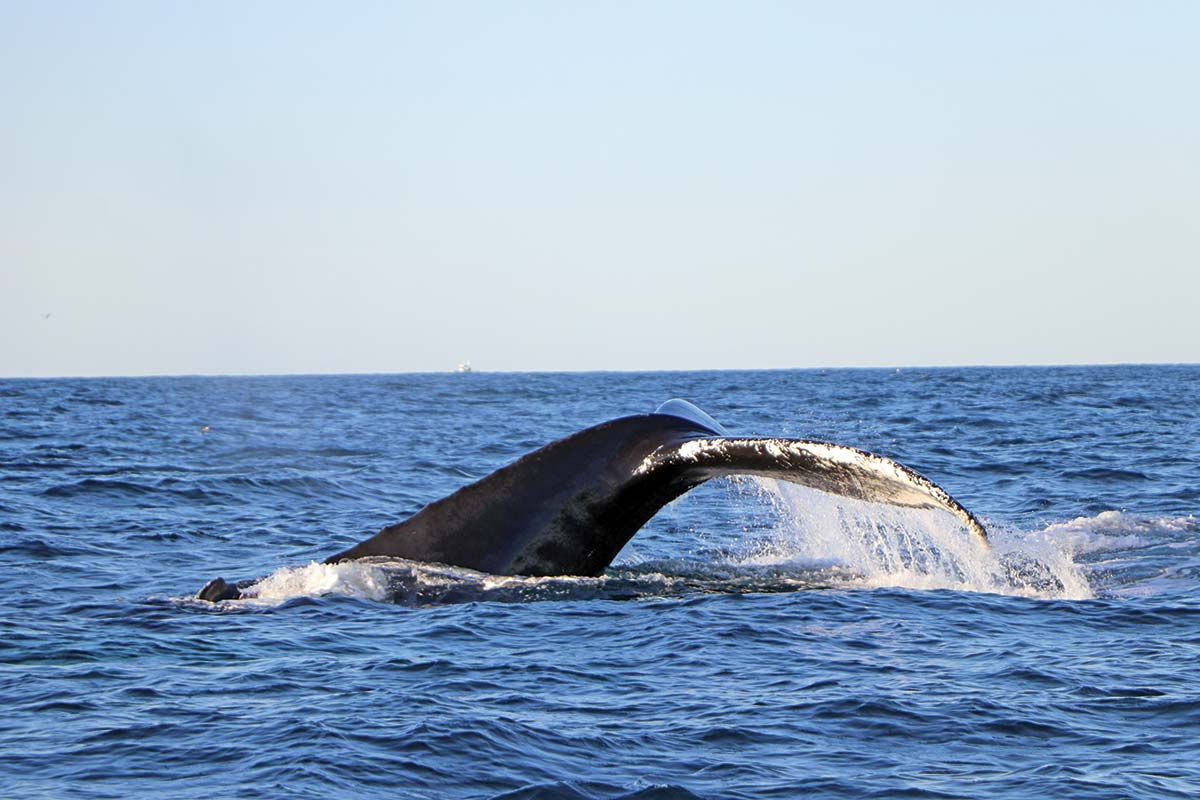
The Humpback
Humpback whales are just iconic – they’re big, cool looking, unafraid of humans and are often at the center of the hottest fishing action around. Humpbacks are “gulp feeders” meaning they prefer dense clouds of smaller prey (usually krill or tiny shrimp, sand eels, and particularly in recent years, menhaden) and eat by swimming below the school and rushing upwards with their huge mouths wide open and gulping a mouthful of little wriggly goodies, then filtering the mouthful back through their baleen and swallowing.
One specialized method of feeding seen in humpbacks is “bubble-feeding” and it’s just awesome to see. Several whales work together, diving down and circling around the school of bait while releasing huge clouds of bubbles from their mouths. The bubbles act like a net to the baitfish, and they pack tighter and tighter, until one or more of the whales comes rushing to the surface to take an enormous gulp of tightly-packed protein. This action definitely attracts birds above the water (again, binoculars are your friend) and hungry tunas down below, no doubt attracted by all the underwater noise and mayhem of a humpback feed.
These spectacular offshore events often occur right at first light, and around tide changes. Seeing a ring of bubbles the size of a swimming pool, spiraling around and around in a circle until a couple whale maws come bursting up through, well, that’s about as cool a thing as any landlubber or salty captain can witness, and a prime sign to put your baits out in the immediate area.
Here comes the caveat: finding humpback whales actively feeding is as good a sign as one can see for finding tunas, but there are times when the whales are also bunched up and not feeding. When the whales start slapping their fins on the surface, smacking the top over and over, when they repeatedly pound the water with their tails (called “lobtailing”), and especially when they start breaching, those mind-blowing, almost full-body leaps out of the water, crashing down with a blast of spray that would soak a football field, well, folks – that means the tuna show is over. It’s hard to leave the sign you waited so patiently for during the long run in the dark, but it may be your best move.
I’ve asked several whale biologists, and from my own experience and observations, once the whales start those actions, they are no longer feeding, and probably acting socially with each other. These social behaviors almost always occur after a period of feeding behaviors, and as awesome as they are to witness, if you’re trying to get a bite it’s time to look elsewhere. Often the whales will stay in the same general are that they were feeding in, waiting for the next favorable tide while the bait runs deeper, but if they aren’t actively feeding – bubbling, gulping and the like – the tuna that love that action have temporarily moved on as well.
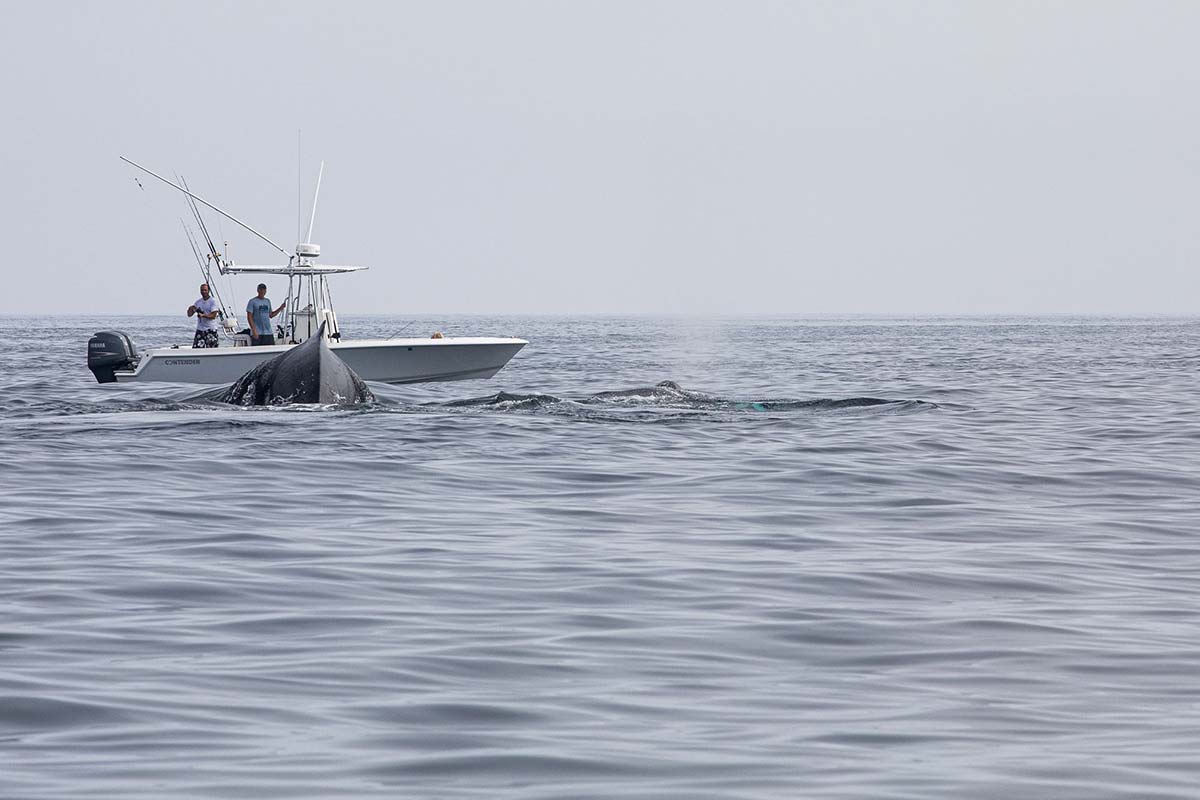
Minkes & Dolphins
Minke whales are a smaller species that almost look like a huge porpoise. They have teeth, not baleens, and chase and eat their food one at a time. They are remarkably fast and agile, and often appear in loose groups of up to a dozen or so. Minkes feed on larger forage than humpbacks, usually seeking out full-sized herring, mackerel or even halfbeaks, and their mode of feeding is much more active than gulping whales. Minke whales, when they’re on bait, “slash” through the water, moving fast and chasing hard, particularly on top. Finding actively feeding minkes is, I believe, perhaps the best whale sign a tuna fisherman can find – they are eating exactly what tuna prefer to eat, they are chasing and feeding in the same way as the tuna are, and more often than not tell you that you’re in the best possible spot to hope for a bite.
In many parts of the world, finding dolphins or porpoises feeding means you’ve found the tuna – just put out a bait or start casting. But in my experience, off the Northeast Atlantic coast, the relationship is much less direct. Yes, there can be tuna swimming with the huge schools of dolphins, and they may feed together, but it seems the attraction is far less than it is with other marine mammals. I know one veteran captain from the Cape who swears that tuna envy the dolphins, and will follow them for just a little bit before giving up. If I see a large pod of dolphins flying across the ocean surface, I chalk it up to “good life” and a positive sign, but not a home run like seeing other mammal species feeding away.
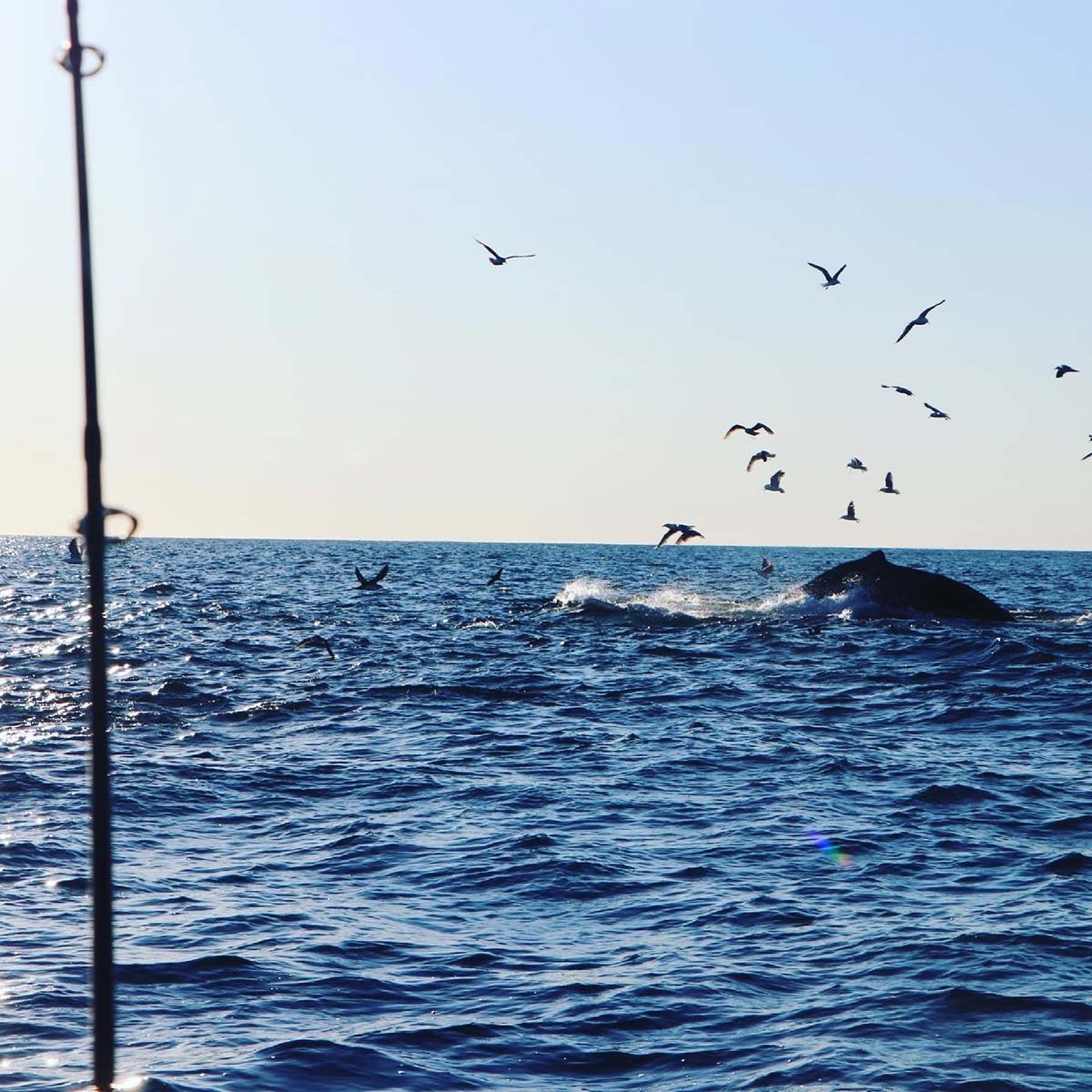
Pilot Whales
Another important whale species for Northeast fisherman are pilot whales. These are also smaller, toothed whales that live in groups of anywhere from 30 to 100 or more individuals. They feed primarily on squid, and will dive down to 1,800 feet in search of their favorite prey. When we encounter them in the Northeast canyons, grouped up and feeding, that means you’ve landed on the motherland of the bait.
Again, if the pod is moving rapidly along the top, clearly headed from one place to another, that’s good sign but not great sign. What one really wants to see is the pod of pilot whales surfacing, breathing, and arching their backs to dive down to the depths. It’s not a spectacular visual sign, but it means they have found a large biomass of squid and are feasting away down in the deep. I cannot stress this enough – if you are seeking tuna, marlin or other pelagic species, and you find pilot whales arching and diving – do not leave! The tuna species – bigeye, yellowfin and albacore – are feasting deep as well, and your best bet for a bite is to be patient and work the area until the bait and tuna rise up enough to be within range of chunk baits, jigs or trolled lures.
In such a scenario (like the wide-open bite at the Fishtails a few years back, which featured acres of pilot whales), your best bet is to read the sign of bait below and be patient – the bites will come.
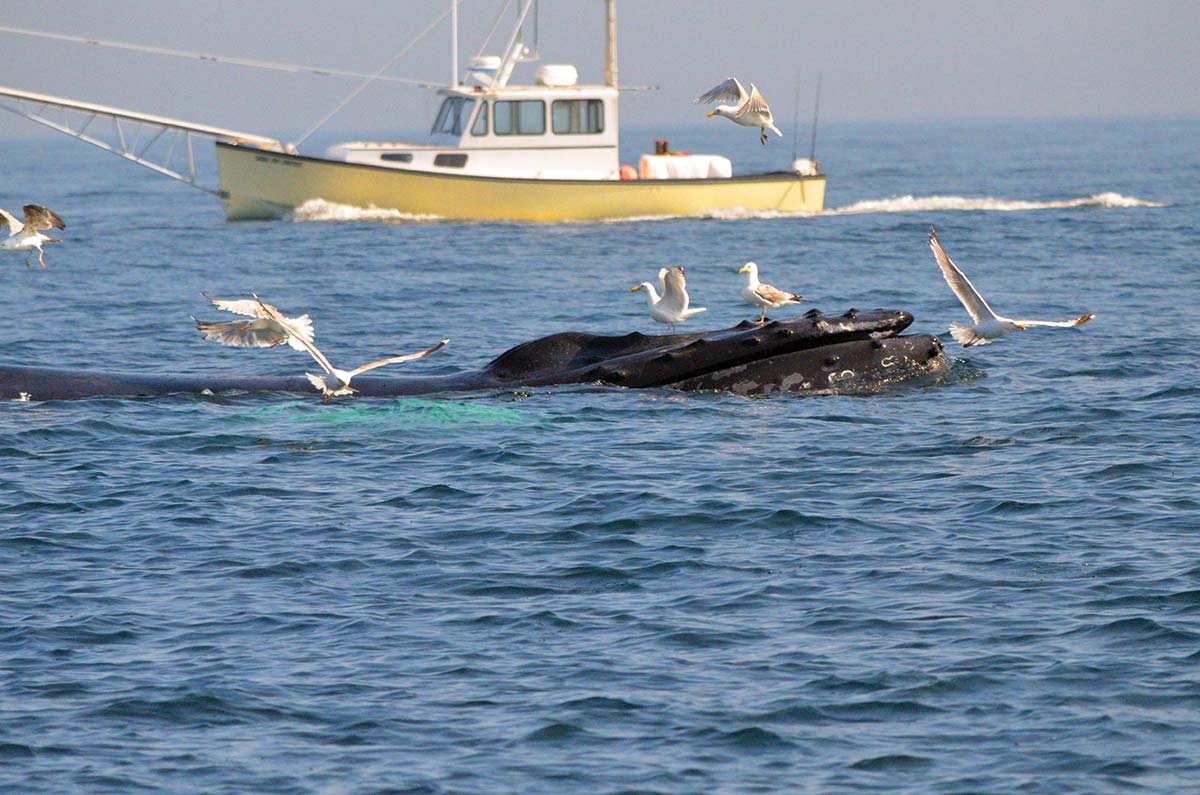
Proceed With Caution
I must add, there have been a few close calls in recent years with fishing boats getting too close to whales, particularly around the massive inshore schools of menhaden. Nobody needs to end up on the 6 o’clock news because they thought they would catch a gamefish from out of a whale’s mouth. Use common sense here – not only are you putting your boat and crew in danger, but the best fishing is often on the periphery of the bait school rather than right on top of it. The sound, smell and visual chaos of a whale feed draws fish in from great distances, it’s best to keep a safe distance away from the leviathans and follow through with what brought you out there in the first place, getting tight and a screaming reel.
Finding whales offshore is one of the first goals any boat should try and accomplish on an offshore fishing trip. Refining your understanding of not just where the whales are, but what they are currently doing, can spell the difference between a full fish box and a lovely whale-watching trip. These are amazing and awe-inspiring creatures, who depend daily on finding the very bait we so desperately look for as anglers. If they’re on the chew, stay tight to the area, as the gamefish will likely be doing the same. If the whales are showing other behaviors, like traveling or acting socially, the time has come to seek out more fertile waters, or at least stay patiently with the whales until the feed begins again, though that may take up to six hours for the next tide change.
Try to watch and learn each time you are blessed enough to fish around these magnificent giants, and when the trophy is landed, tip your cap to the whales that helped make it all happen.




